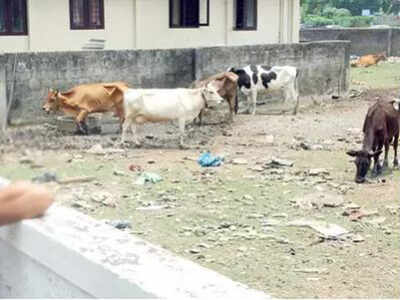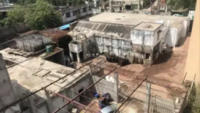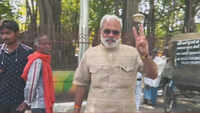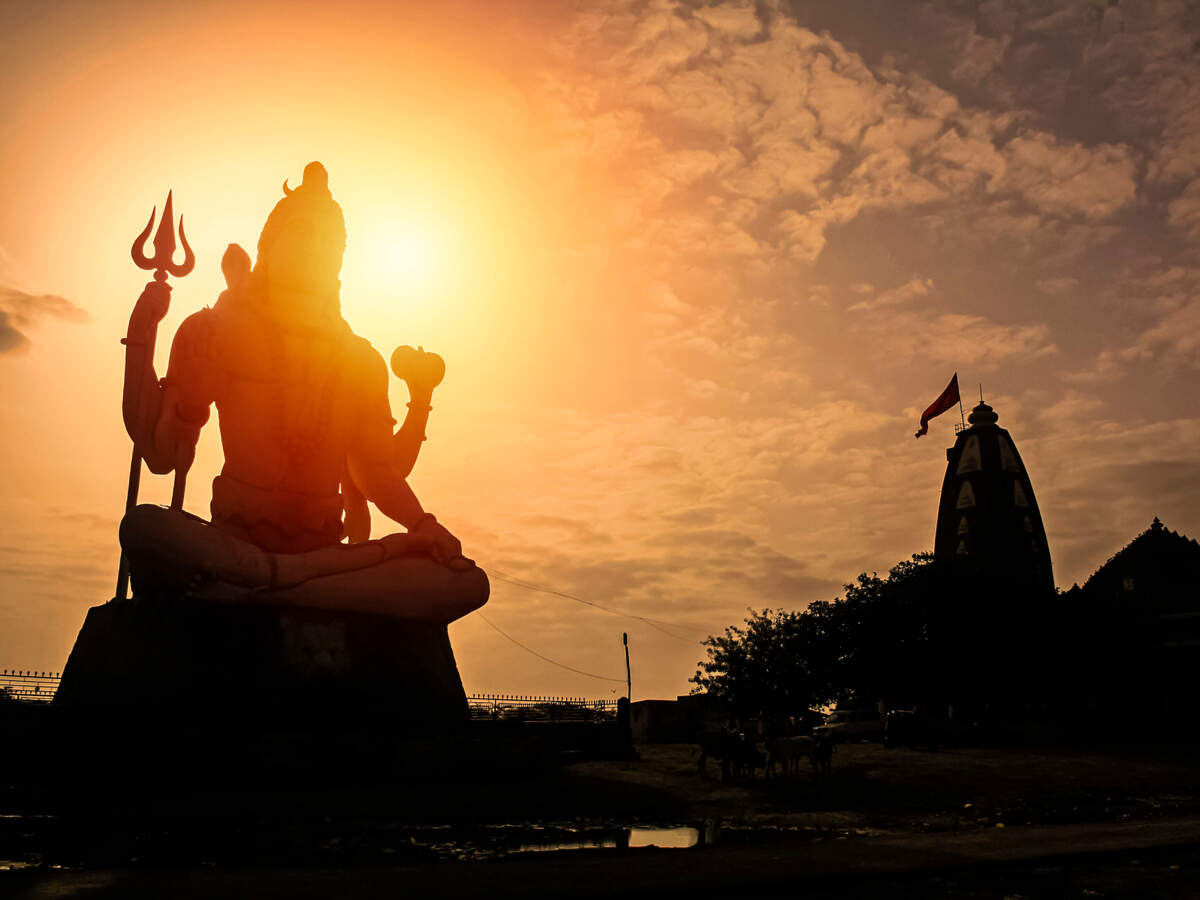
LALITPUR/MAHOBA: The sprawling 1500 acre ‘Gau Vansh Ashray Sthal’, a shelter for stray cows, is the centrepiece of Kalyanpura village in Bundelkhand’s Lalitpur district. Set up by the UP government last year to accommodate 5000 strays, it houses 2,200 stray cows at present, most ambling around wearing bright yellow barcoded tags on their ears.
The shelter’s supervisor, Pawan Kumar Rajput, tells TOI that once inside, the cattle is not allowed to leave, reining in, he says, the region’s stray cattle menace.
In Bundelkhand, the ‘anna pratha’ or the tradition of abandoning cattle when farmers are unable to feed them, is not new. The ratio of cattle to human population in Bundelkhand, Sai Jyoti Sansthan’s Ajay Srivastava says, is almost equal. Therefore, no cattle shelter can be large enough to accommodate all the strays roaming the roads.
This time though, the problem of strays, once largely restricted to Bundelkhand, has gripped the bulk of UP, with the man-animal conflict leading to simmering anger and deepened farm distress.
It is for this reason that the stray cattle menace has also crept into political speeches on UP’s poll pitch. Across Etawah, Kannauj, Kanpur, Jalaun, Jhansi, Lalitpur and Mahoba where TOI travelled, free-roaming cattle has hit the farm economy.
Simply put, farmers largely rear cattle for milk, but they also help them till farm land and double up for ferrying goods and people. When they got older and stooped producing milk, they were abandoned to be sold to abattoirs for their hide, hooves, bones and hair. This economic cycle has now been disrupted. Facing poor yields and farm distress, farmer let loose their cattle to find its own food. Since buffalos yield more milk, they are relatively less prone to being abandoned. Cows, on the other hand, with lower yields of milk, bear the brunt.
Pushpendra Bhai, who runs the Apna Talab Abhiyan across Bundelkhand’s Banda, Chitrakoot and Mahoba districts, tells TOI that the traditional farming economies where cattle played a central role is gradually changing. “On the farm, the utility of the cow is shrinking. With increased mechanisation, and the use of chemical fertilisers instead of organic manure, the use of cattle is making way for market forces where everyone is focusing on higher yields and more profits. So cows are forcibly abandoned,” he says.
With the rise of cow vigilantism, another recent phenomenon, farmers are now wary of keeping older cattle and prefer to abandon animals. The immediate fall out is at the farm level. Apart from the blue bull (nilgai), strays also raid farms in search of fodder, destroying crops in the process. It is not an uncommon sight, therefore, to find lathi-wielding farmers chasing away strays. “Strays have deepened our farm crises. They destroy everything we sow. Though the government claims it will set up animal shelters, they are mostly useless, and not enough,” says Ram Kumar, a contract farmer in Kannuj’s potato belt.
The lower castes among the rural population are also impacted. Sections of the Dalit community would collect the dead animals disposed by farmers on the outskirts of villages. They would then skin the dead animal and make a living in the process. This too had been hit.
Even as farm incomes are hit and a deeper malaise grips Uttar Pradesh rural parts, politicians have largely looked the other way. Chief minister Yogi Adityanath, whose government in UP announced its commitment towards conservation of cattle, and allocated Rs 248 crore for construction and maintenance of ‘gaushalas’, said stray animals were only goring those who ran abattoirs. This was in response to SP and BSP chiefs Akhilesh Yadav and Mayawati claiming BJP was letting them loose in their rallies to disrupt them.
Between the exchange of political barbs, though, its both the man and the animal who are taking a beating.
The shelter’s supervisor, Pawan Kumar Rajput, tells TOI that once inside, the cattle is not allowed to leave, reining in, he says, the region’s stray cattle menace.
Just a few kilometres away on the Jhansi-Lalitpur highway, however, a cluster of yellow barcode-tagged cows have brought traffic to a halt as they criss-cross the road. They have escaped Rajput’s watchful eye.
In Bundelkhand, the ‘anna pratha’ or the tradition of abandoning cattle when farmers are unable to feed them, is not new. The ratio of cattle to human population in Bundelkhand, Sai Jyoti Sansthan’s Ajay Srivastava says, is almost equal. Therefore, no cattle shelter can be large enough to accommodate all the strays roaming the roads.
This time though, the problem of strays, once largely restricted to Bundelkhand, has gripped the bulk of UP, with the man-animal conflict leading to simmering anger and deepened farm distress.
It is for this reason that the stray cattle menace has also crept into political speeches on UP’s poll pitch. Across Etawah, Kannauj, Kanpur, Jalaun, Jhansi, Lalitpur and Mahoba where TOI travelled, free-roaming cattle has hit the farm economy.
Simply put, farmers largely rear cattle for milk, but they also help them till farm land and double up for ferrying goods and people. When they got older and stooped producing milk, they were abandoned to be sold to abattoirs for their hide, hooves, bones and hair. This economic cycle has now been disrupted. Facing poor yields and farm distress, farmer let loose their cattle to find its own food. Since buffalos yield more milk, they are relatively less prone to being abandoned. Cows, on the other hand, with lower yields of milk, bear the brunt.
Pushpendra Bhai, who runs the Apna Talab Abhiyan across Bundelkhand’s Banda, Chitrakoot and Mahoba districts, tells TOI that the traditional farming economies where cattle played a central role is gradually changing. “On the farm, the utility of the cow is shrinking. With increased mechanisation, and the use of chemical fertilisers instead of organic manure, the use of cattle is making way for market forces where everyone is focusing on higher yields and more profits. So cows are forcibly abandoned,” he says.
With the rise of cow vigilantism, another recent phenomenon, farmers are now wary of keeping older cattle and prefer to abandon animals. The immediate fall out is at the farm level. Apart from the blue bull (nilgai), strays also raid farms in search of fodder, destroying crops in the process. It is not an uncommon sight, therefore, to find lathi-wielding farmers chasing away strays. “Strays have deepened our farm crises. They destroy everything we sow. Though the government claims it will set up animal shelters, they are mostly useless, and not enough,” says Ram Kumar, a contract farmer in Kannuj’s potato belt.
The lower castes among the rural population are also impacted. Sections of the Dalit community would collect the dead animals disposed by farmers on the outskirts of villages. They would then skin the dead animal and make a living in the process. This too had been hit.
Even as farm incomes are hit and a deeper malaise grips Uttar Pradesh rural parts, politicians have largely looked the other way. Chief minister Yogi Adityanath, whose government in UP announced its commitment towards conservation of cattle, and allocated Rs 248 crore for construction and maintenance of ‘gaushalas’, said stray animals were only goring those who ran abattoirs. This was in response to SP and BSP chiefs Akhilesh Yadav and Mayawati claiming BJP was letting them loose in their rallies to disrupt them.
Between the exchange of political barbs, though, its both the man and the animal who are taking a beating.
#ElectionsWithTimes
more from times of india cities
Elections 2019

Trending Topics
LATEST VIDEOS
More from TOI
Navbharat Times
Featured Today in Travel
Quick Links
Lok Sabha Election Schedule 2019Lok Sabha Election NewsDelhi Capitals teamMI team 2019Rajasthan Royals 2019RCB team 2019Maharashtra Lok Sabha ConstituenciesBJP Candidate ListBJP List 2019 TamilnaduShiv Sena List 2019AP BJP List 2019Mamata BanerjeeBJP List 2019 MaharashtraPriyanka GandhiBJP List 2019 KarnatakaAMMK Candidate List 2019BJP List 2019 WBLok Sabha Elections in Tamil NaduBSP List 2019 UPNews in TamilLok Sabha Poll 2019Satta Matka 2018PM ModiMahagathbandhanNagpur BJP Candidate ListChandrababu NaiduTamil Nadu ElectionsUrmila MatondkarNews in TeluguMadras High CourtTejashwi YadavArvind KejriwalTejasvi SuryaPawan KalyanArvind KejriwalYogi AdityanathJaya PradaSatta King 2019Srinagar encounter
Get the app










